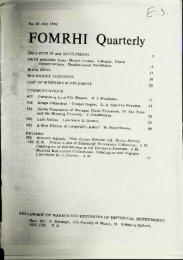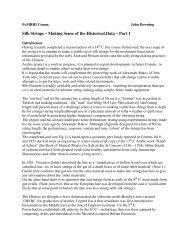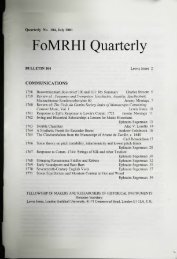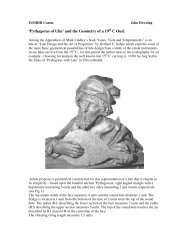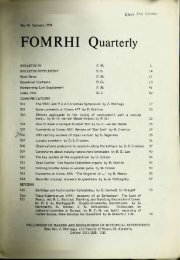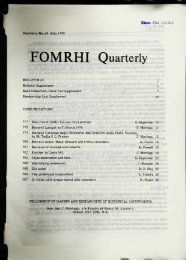• I f - FoMRHI
• I f - FoMRHI
• I f - FoMRHI
You also want an ePaper? Increase the reach of your titles
YUMPU automatically turns print PDFs into web optimized ePapers that Google loves.
12.<br />
accurate and the authors demonstrated their own system of perspective. We do not<br />
know why so many authors published unrealistic illustration: presumably for the lack<br />
of historical instructions given to the painters, the lack of technical and graphical<br />
informations (ancient systems of perspective), as well as the lack of actual musical<br />
instruments, which old painters would have had to know. In fact, it is arbitrary to<br />
distingue how many are "the indications of truth" of the evidences we found in<br />
paintings and in books, if we are not able to make such distinctions "storicizmg" the<br />
images.<br />
Surely what we read in the images is a possible matter for arguing. That is, to<br />
superimpose onto the psichological reaction perceived in front of an image what we<br />
already know about the subject depicted. I accept that cognitions grow according to<br />
the number of observation done: but having got informations from pictures it doesn't<br />
mean that we improve our knowledges of technological details of instruments, but<br />
only of artistic details of pictures: I think that it is arbitrary to affirm that the "level of<br />
truth" of an image increases by comparing it with another image, being both images<br />
not less imaginary perceived. Therefore, in my opinion, the "level of truth" of a picture<br />
can only be increased by comparing it with the actual object which it is the image of. I<br />
would like to quote Peter Holman s opinion (Four and Twenty Fiddlers, Qarendom<br />
Press, Oxford 1995 1 , p. 3): "...More generally, pictures reinforce the traditionally idea<br />
that instruments should be defined by their shape. A bowed instrument in a painting<br />
is accepted as a violin if its body shape conforms sufficiently to our notions of what an<br />
early violin should look like - notion that have been fashioned mainly by the<br />
subsequent history of the violin, and die development of its 'classic' shape. Not only it<br />
is perilously close to being a circular argument, but it also places an unreasonable<br />
emphasis on what seems to have been the most variable aspect of bowed instruments<br />
at the time".<br />
According to what almost all contemporary scholars think, we have no ways (nor<br />
reasons) to discern what content of evidence "of truth" is in pictorial images, non only<br />
as mey are products of imagination, but also because the level of "realism" is not<br />
definable. What concerns old pictures in general, it is sufficient to observe me<br />
extremely large number of common objects - buildings, trees and musical instruments<br />
too - not obeying the rules of Renaissance perspective depicted from prehistory to<br />
modern times. Moreover, even E.Winternitz openly admitted drat especially Filippino<br />
Lippi Piero de Cosimo and Lorenzo Costa depicted imaginary musical instruments.<br />
The plain fact is that in order to represent an object, a picture must be a symbol for it, stand for<br />
it, refer to it; and that no degree of resemblance is sufficient to establish the requisite<br />
relationship of reference. Nor is resemblance necessary for reference; almost anything may<br />
stand for almost anything else (Goodman, p.5, but this concept was found already in<br />
S.Augustin's writings). One can explain this way what are deviations from the rules of<br />
Renaissance perspective which so a few old drawings obey. The laws of perspective are<br />
supposed to provide absolute standards of fidelity that override differences in style of seeing<br />
and picturing (Goodman, p.10). It can also be argued, that this statement is not<br />
properly true, because it is impossible to see the picture from the same point of view<br />
from which the painter saw the object (one only has to remember the picture showing<br />
which way a Renaissance painter - Durer and others - drew pictorial images).





